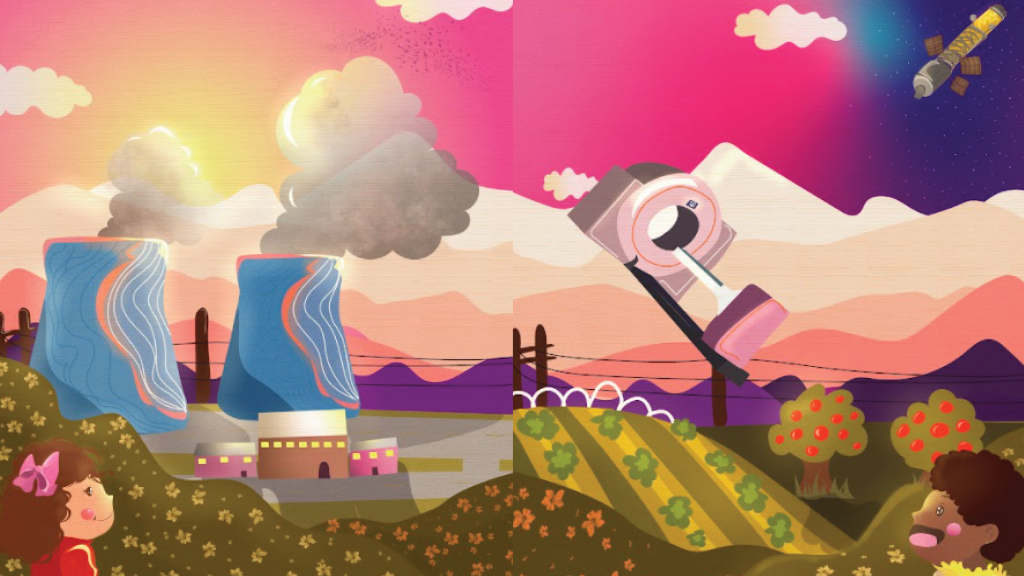A Nuclear Future
by Emi Knape | published Nov. 12th, 2021
Nuclear power: a concept often associated with the Cold War — specifically the Arms Race — between the United States and the Soviet Union in the 1950s; an event resulting in the development of 65,000 nuclear weapons. Similarly, with stories of nuclear power plant meltdowns in countries such as Ukraine and Japan, many people are weary about the idea when brought up in relation to the U.S.
Starting With Safety
Throughout the 1950s, many of the advances in nuclear energy were focused on developing the safety precautions used within the reactors — primarily with the intent of anticipating and preventing accidents before they occur. Tom Wellock, historian for the U.S. Nuclear Regulatory Commission (NRC), has a good understanding of how safety was viewed during the '50s and how it has further evolved and expanded throughout the continuous decades.
“In the 1950s, the history of dealing with reactors started with production reactors, which made plutonium and gave [engineers] the basis for approaching safety," Wellock said. “They took more of a hardware approach to anticipate what could go wrong.”
Help From Humans
As time progressed through the '60s and '70s, more emphasis was put on preventing accidents that had never happened before, which couldn’t be determined with hardware alone. Technology wasn’t able to cope with unplanned events and accident management. Running a power plant requires a human element, so the training needed to be as advanced as the tech.
“The simple focus on hardware needed to be supplemented with human beings and training. Seeing them as an essential role in pursuing safety was a more sophisticated approach,” Wellock explained.
"The simple focus on hardware needed to be supplemented with human beings and training."
With the human element of accident prevention solved, there were more conversations during the 1980s about building nuclear power plants and reactors with advanced technologies, such as “defense in depth.” This mechanical approach was designed to prevent accidents that could release radiation and other hazardous materials. Nuclear reactors built and operated with these new methods anticipated and prevented some of nuclear power's largest issues, such as excursion and radiation leakage.
With potential issues constantly popping up over time, nuclear prevention technologies had to advance as well. For example, the industry put a sizable investment into “light water reactors,” which essentially use water as a cooling method for the reactors. The idea was simple, and seemingly effective, but many people still had concerns about the efficiency of this new technology.
“The nuclear navy focused on the water reactors, so people turned to them,” Wellock stated. “However, some people for years have criticized it as a ‘wrong turn in technology’ — [the idea was too simple] and reactors with higher pressure may have been better in retrospect.”
While water cooling technologies may have been a debatable way to go, it paved the way for what nuclear technology looks like today. Currently, there are lots of ideas based around improvements of different technologies, such as the light water reactors, that have been around for a long time.
Environmental Alternative
Aside from improvements in safety, nuclear energy has also undergone lots of growth in terms of sustainability. For example, engineers and experts are constantly thinking of new ways to mine and manufacture uranium, thus reducing its impact on the environment.
As an alternative to fossil fuels, which make up 84 percent of the world’s energy, nuclear has the potential to have a positive environmental effect and even possibly help prevent climate change. However, many controversies commonly arise in regards to cost and efficiency.
Eric Hittinger is a Public Policy professor at RIT where he teaches classes relating to decision analysis and climate change. With a background in energy and electrical systems as well, Hittinger is able to give insight into the practicality of nuclear energy compared to other types such as wind and solar.
“Nuclear energy is the largest source of zero carbon electricity, but it’s not growing, [whereas] wind and solar are small but growing very rapidly. They are driven by government support and economics, so costs are going down,” Hittinger explained.
Quite the Cost
So, while nuclear energy is ideally the best way to reduce carbon emissions, the cost to make the switch is a significant issue. For one thing, building high-quality power plants is an expensive endeavor in of itself, and taking in employees and the cost of uranium, there really is no “fixed price” for this type of project.
The biggest challenge is overcoming the uncertainty capital because nuclear reactors don't have a set cost. According to Hittinger, when thinking about the construction of new power plants, the most common question asked by prospective plant managers is, “How much would I have to charge for this power plant just to break even?”
“We can’t seem to build a power plant in the west with a cost that seems to be acceptable,” Hittinger said. “We want cheap, clean electricity.”
“We can't seem to build a power plant in the West with a cost that seems to be acceptable. We want cheap, clean electricity.”
A Nuclear Future
Despite the fact that nuclear energy is more costly and there is a lot of uncertainty, there are still many propositions for new nuclear technologies, such as small modular reactors. These would be built in factories as opposed to on-site, leading to lower costs and higher quality. While these reactors don’t exist yet and are in various stages of development and approval, it shows that there is still a potential future for the field.
Throughout history, nuclear energy has gone through many advances in safety and sustainability, making it an ideal energy source even today. While the costs are high and the technology is still questionable, the idea of a nuclear future is not entirely impossible. With constant and innovative advancements, there is still potential for nuclear energy to power the world!



